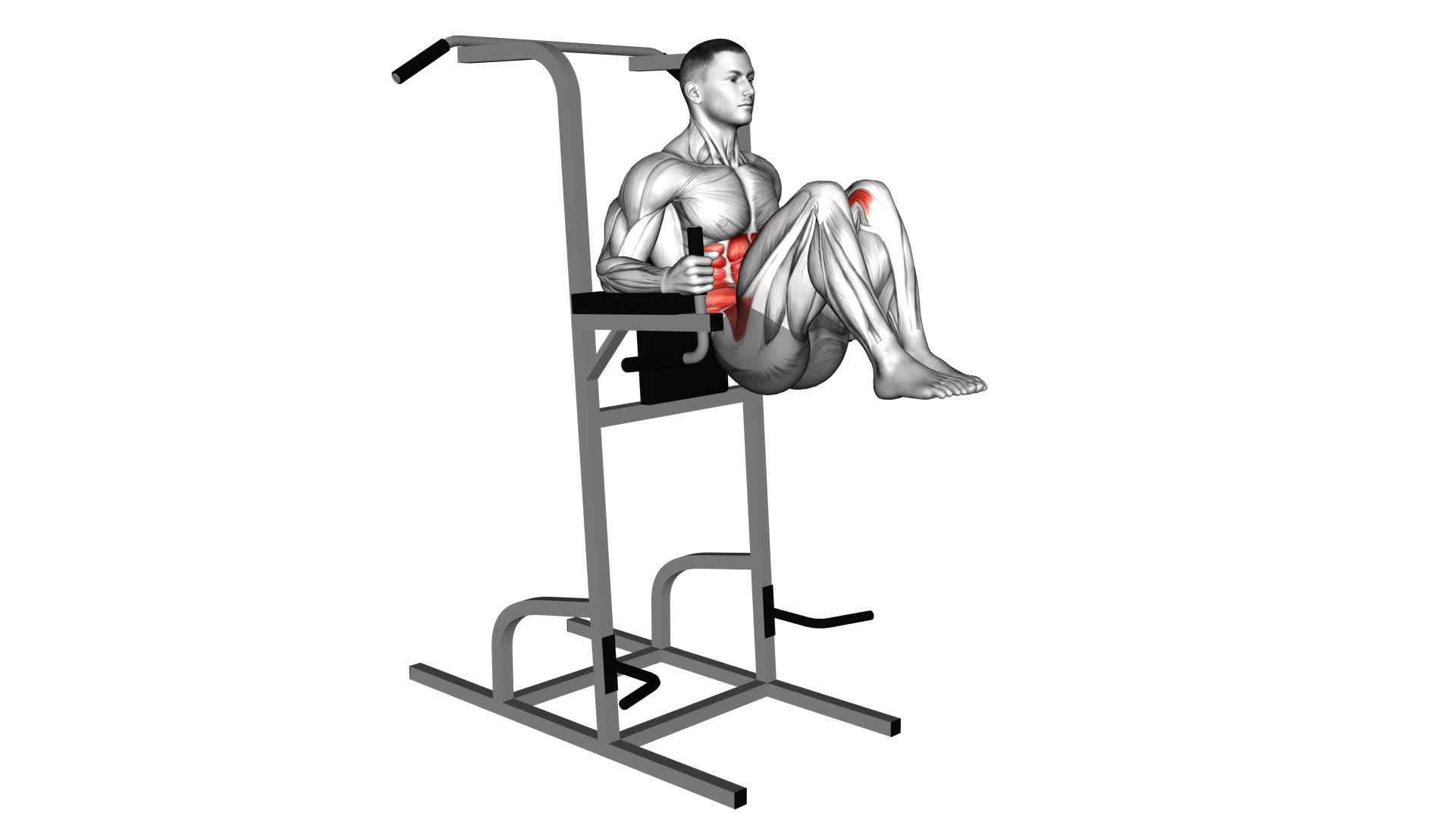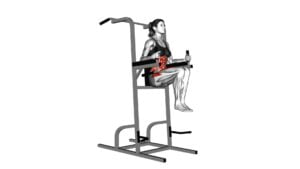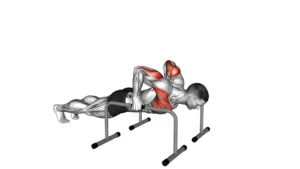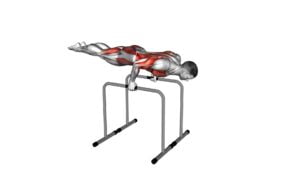Vertical Leg Raise (On Parallel Bars) – Video Exercise Guide & Tips

Looking to strengthen your core and build impressive abdominal muscles? Look no further than the vertical leg raise on parallel bars. This exercise targets your lower abs, hip flexors, and obliques, giving you a rock-solid midsection.
Watch This Exercise Video
In this video exercise guide, we'll show you the proper form and technique, common mistakes to avoid, and tips to maximize your results.
Get ready to take your vertical leg raise game to new heights!
Key Takeaways
- Vertical Leg Raise on Parallel Bars targets lower abs, hip flexors, and obliques
- Proper form and technique are essential for a successful Vertical Leg Raise
- Common mistakes to avoid include swinging legs and neglecting a full range of motion
- To maximize results, engage core muscles, focus on breathing technique, and vary the exercise with different variations and progressions
Benefits of Vertical Leg Raise on Parallel Bars
Discover the numerous benefits you can experience by incorporating vertical leg raises on parallel bars into your exercise routine. This exercise primarily targets your abdominal muscles, specifically the rectus abdominis and the obliques. As you lift your legs, you engage these muscles to stabilize your body and maintain proper form. This not only helps to strengthen and tone your abs, but it also improves your core stability and balance.
In addition to targeting your abs, vertical leg raises on parallel bars also engage your hip flexors and lower back muscles. These muscles work together to lift your legs and maintain control throughout the movement. By incorporating this exercise into your upper body workout routine, you can effectively target multiple muscle groups and achieve a more well-rounded workout.
To incorporate vertical leg raises on parallel bars into your routine, start by gripping the parallel bars with your hands slightly wider than shoulder-width apart. Hang from the bars with your legs extended and feet together. Engage your core and lift your legs up towards your chest, keeping your knees straight. Slowly lower your legs back down to the starting position, maintaining control throughout the movement.
Proper Form and Technique for Vertical Leg Raise
To perform a proper vertical leg raise on parallel bars, position your hands slightly wider than shoulder-width apart on the bars and hang with your legs extended and feet together.
Now that you're in the starting position, let's discuss some important aspects of proper form and technique for this exercise.
One common misconception about the vertical leg raise technique is that swinging your legs will make the exercise more effective. However, this is incorrect. To maximize the benefits of this exercise, it's crucial to minimize swinging and focus on controlled movements. This will engage your core muscles more effectively and prevent unnecessary strain on your lower back.
Speaking of the lower back, it's essential to take precautions to prevent strain during vertical leg raise. One way to do this is by maintaining proper posture throughout the exercise. Keep your back straight and avoid arching or rounding it. Engage your core muscles and use them to lift your legs, rather than relying solely on your hip flexors. This will distribute the workload more evenly and protect your lower back from excessive strain.
Common Mistakes to Avoid During Vertical Leg Raise
Avoid swinging your legs during the vertical leg raise exercise on parallel bars to ensure proper form and maximize its effectiveness. Swinging your legs not only decreases the effectiveness of the exercise but also increases the risk of injury. Here are some common mistakes to avoid during the vertical leg raise:
- Using momentum: Swinging your legs to lift them up takes away the focus from your abdominal muscles and reduces the effectiveness of the exercise. Instead, engage your core muscles and use controlled movements to lift your legs.
- Lifting your legs too high: Lifting your legs higher than your hips can strain your lower back and put unnecessary pressure on your spine. Aim to lift your legs until they're parallel to the ground, maintaining a 90-degree angle at the hips.
- Neglecting proper breathing: During the leg raise, it's important to inhale as you lower your legs and exhale as you lift them up. Proper breathing helps stabilize your core and supports your movements.
- Not maintaining a neutral spine: Avoid arching your back or rounding your shoulders during the exercise. Keep your spine straight and your shoulders relaxed to prevent injuries and maintain proper form.
- Neglecting a full range of motion: Lowering your legs only halfway down limits the benefits of the exercise. Aim to lower your legs until they're just above the ground, maintaining control throughout the movement.
Tips to Maximize Your Results With Vertical Leg Raise
To improve your results with the vertical leg raise, focus on maintaining proper form and engaging your core muscles throughout the exercise. Core engagement is crucial for this exercise as it helps stabilize your body and prevents unnecessary strain on your lower back. To engage your core, imagine pulling your belly button towards your spine and actively contracting your abdominal muscles. This will create a solid foundation for the movement and allow you to lift your legs with control and stability.
In addition to core engagement, pay attention to your breathing technique. It's important to exhale as you lift your legs and inhale as you lower them back down. This helps you maintain a steady rhythm and prevents you from holding your breath, which can increase tension in your muscles and compromise your form.
By focusing on core engagement and proper breathing technique, you'll maximize the effectiveness of the vertical leg raise exercise and achieve better results. These tips will help you build strength in your abdominal muscles and improve your overall stability.
Now, let's explore some variations and progressions for the vertical leg raise that can further challenge your core muscles and take your workout to the next level.
Variations and Progressions for Vertical Leg Raise
Try incorporating variations and progressions into your vertical leg raise routine to challenge your core muscles and take your workout to the next level. By adding advanced variations to your training program, you can continue to improve your strength and stability while targeting different muscle groups.
Here are five advanced variations to try:
- Single Leg Vertical Leg Raise: Lift one leg at a time, keeping the other leg extended straight out in front of you. This variation increases the demand on your core muscles and improves balance.
- L-Sit Vertical Leg Raise: While performing the leg raise, lift your legs up until they're parallel to the ground, forming an L-shape with your body. This variation strengthens your core and requires strong upper body strength.
- Weighted Vertical Leg Raise: Hold a dumbbell or weighted plate between your feet while performing the leg raise. This variation adds resistance and increases the intensity of the exercise.
- Side-to-Side Vertical Leg Raise: Instead of raising your legs in the front, raise them to the sides, alternating between left and right. This variation targets your obliques and adds a rotational element to the exercise.
- Hanging Vertical Leg Raise: Perform the leg raise while hanging from a pull-up bar or gymnastic rings. This variation challenges your grip strength and engages your upper body muscles.
Incorporating these advanced variations into your training program will help you continue to progress and challenge your core muscles. Remember to focus on proper form and start with lighter progressions before advancing to more difficult variations.
Frequently Asked Questions
How Many Repetitions Should I Aim for When Doing the Vertical Leg Raise on Parallel Bars?
When doing the vertical leg raise on parallel bars, aim for a number of repetitions that challenges you without sacrificing form. Start with a manageable number, like 8-10 reps, and gradually increase as you get stronger.
For beginners, you can modify the exercise by bending your knees slightly or reducing the range of motion.
To improve core strength during the leg raise, focus on engaging your abdominal muscles and maintaining a stable upper body position.
Can I Perform the Vertical Leg Raise on Parallel Bars if I Have Lower Back Pain?
If you have lower back pain, it's important to be cautious when performing the vertical leg raise on parallel bars. This exercise puts strain on your lower back and could worsen your pain.
Instead, try alternative exercises that don't put as much pressure on your lower back, such as gentle stretching and strengthening exercises.
These exercises can help alleviate your lower back pain and improve your overall flexibility and strength.
Is It Necessary to Use Parallel Bars for the Vertical Leg Raise, or Can I Use Other Equipment?
When performing the vertical leg raise, it isn't necessary to use parallel bars. There are alternative equipment options available, such as dip bars or captain's chair, that can be used for this exercise.
These alternatives provide a stable base and support for your body while performing the leg raise. Additionally, modifications can be made to the exercise to suit your fitness level and any physical limitations you may have.
How Long Should I Rest Between Sets of Vertical Leg Raises on Parallel Bars?
To ensure optimal results and avoid injury, it's crucial to rest between sets of vertical leg raises on parallel bars.
Rest duration depends on your fitness level and goals. Generally, a rest period of 30-60 seconds is recommended. However, listen to your body and adjust accordingly.
During this time, focus on maintaining proper form and technique. Keep your core engaged, legs straight, and avoid swinging. This will maximize the effectiveness of the exercise and minimize the risk of strain.
Are There Any Specific Breathing Techniques I Should Follow While Performing the Vertical Leg Raise on Parallel Bars?
When performing the vertical leg raise on parallel bars, it's important to focus on your breathing technique. You should inhale as you lower your legs and exhale as you raise them. This helps engage your core muscles and maintain stability throughout the exercise.
Additionally, if you have lower back pain, you can modify the exercise by bending your knees slightly or reducing the range of motion. Remember to listen to your body and make adjustments as needed to prevent further discomfort.
Conclusion
In conclusion, the vertical leg raise on parallel bars is an effective exercise for targeting the lower abdominal muscles and strengthening the core. By following proper form and technique, avoiding common mistakes, and implementing tips to maximize results, you can ensure optimal benefits from this exercise.
Additionally, variations and progressions can be incorporated to challenge yourself and continue progressing in your fitness journey. Incorporate the vertical leg raise into your workout routine for a stronger and more defined core.

Author
Years ago, the spark of my life’s passion ignited in my mind the moment I stepped into the local gym for the first time. The inaugural bead of perspiration, the initial endeavor, the very first surge of endorphins, and a sense of pride that washed over me post-workout marked the beginning of my deep-seated interest in strength sports, fitness, and sports nutrition. This very curiosity blossomed rapidly into a profound fascination, propelling me to earn a Master’s degree in Physical Education from the Academy of Physical Education in Krakow, followed by a Sports Manager diploma from the Jagiellonian University. My journey of growth led me to gain more specialized qualifications, such as being a certified personal trainer with a focus on sports dietetics, a lifeguard, and an instructor for wellness and corrective gymnastics. Theoretical knowledge paired seamlessly with practical experience, reinforcing my belief that the transformation of individuals under my guidance was also a reflection of my personal growth. This belief holds true even today. Each day, I strive to push the boundaries and explore new realms. These realms gently elevate me to greater heights. The unique combination of passion for my field and the continuous quest for growth fuels my drive to break new ground.



